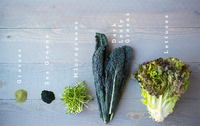Posted by Amazing Grass on 2016 Jul 4th
A Complete Guide to Greens
From detoxifying to immunity boosting, greens are becoming the go-to veggies for wellness.

For quite some time now, greens have been touted as one of nature’s most nutrient-dense foods. Often, they are referred to as superfoods. But how exactly are “greens” defined and how do we know which ones are best? Thankfully, although there are a wide variety of greens, most all of them are packed with important nutrients. In fact, since all greens have different nutritional profiles, it’s recommended that we all eat a diverse mix of greens and not stick to the same thing day in and day out.
Below we outline 5 different types of greens and explain what makes them unique!
Dark Leafy Greens: Dark leafy greens are often the most popular form of greens and the ones that we’re most familiar with. Spinach, kale, collards and chard all fit into this category. All dark leafy greens are great for cooking and some, like spinach and kale, make fantastic additions for smoothies because they are not too bitter. Although dark leafy greens contain a variety of nutrients, most are high in vitamins A, C & K and may help protect you against heart disease, diabetes and cancer. [1]
Sea Greens: You don’t have to be a fan of seaweed salad to enjoy sea greens. Chlorella and Spirulina are two examples of sea algae that you can easily take in supplement or powder form. Sea greens are great for detoxifying and cleansing. Spirulina is also quite high in Vitamin B12, containing over 150% of your daily recommend value. It’s also high in magnesium, zinc and iron. [2]
Lettuces: Lettuces may not get as much attention as some of the other greens on this list, but many are exceptionally high in nutrients. Red and Green leaf lettuce along with Romaine lettuce are high in vitamin A and folate, also known as vitamin B9. Folate has been shown to encourage normal nerve and brain function. [3]
Although varieties like iceberg lettuce have their place, it’s recommended to search for lettuces darker in color. Often, the richer the green color, the higher in nutrients it will be. [2]
Microgreens: Microgreens are a relatively new phenomenon in terms of popularity. Microgreens are the seedlings of common plants like kale, beets, etc. They are most commonly used on top of salads, in sandwiches and as a garnish to give a dish a bit of crunch and texture. While young in age, these seedlings are certainly not lacking in nutrient value. In fact, micorgreens have been shown to have up to four to six times more nutrients than the mature leaves of the same plant! [4]
Grasses: Call us biased, but we’re pretty obsessed with grasses. The nutrient profile of grasses like barley grass, alfalfa grass are very similar to most nutritious, dark green veggies. So many animal species on our planet survive almost exclusively on grasses and grasses are such a complete food that you don’t need any other vegetable or animal product to complement them or make up for missing nutrients. Grasses are high in calcium, iron, vitamin C, vitamin B12, even protein. They have been shown to improve our digestive function, detoxify our blood and cleanse our liver. They are all extremely alkalizing and contain a long list of amino acids. [5]
Amazing Grass makes it easy to enjoy these nutritional powerhouse grasses as a part of your daily routine! Check out all of our natural green supplements and powders today.
[1] Nierenberg, Cari. “Leafy Greens – Ranked and Rated”. WebMD. WebMD, 1 March 2011. Web. 8 February 2016.
[2] McClees, Heather. “Chlorella Versus Spirulina: A Showdown of the Green Algae Superfoods”. One Green Planet. n.p., 17 October 2014. Web. 8 February 2016.
[3] “Vitamin B9 – Folate”. DrWeil.com. n.p., n.d. Web. 8 February 2016.
[4] Barclay, Eliza. “Introducing Microgreens: Younger, And Maybe More Nutritious, Vegetables”. NPR. n.p., 30 August 2012. Web. 8 February 2016.
[5] “Barley Grass, Alfalfa and the Other Healthiest Grasses You Should Incorporate Into Your Diet”. Body Ecology: The Way to BE. n.p., n.d. Web. 8 February 2016.

